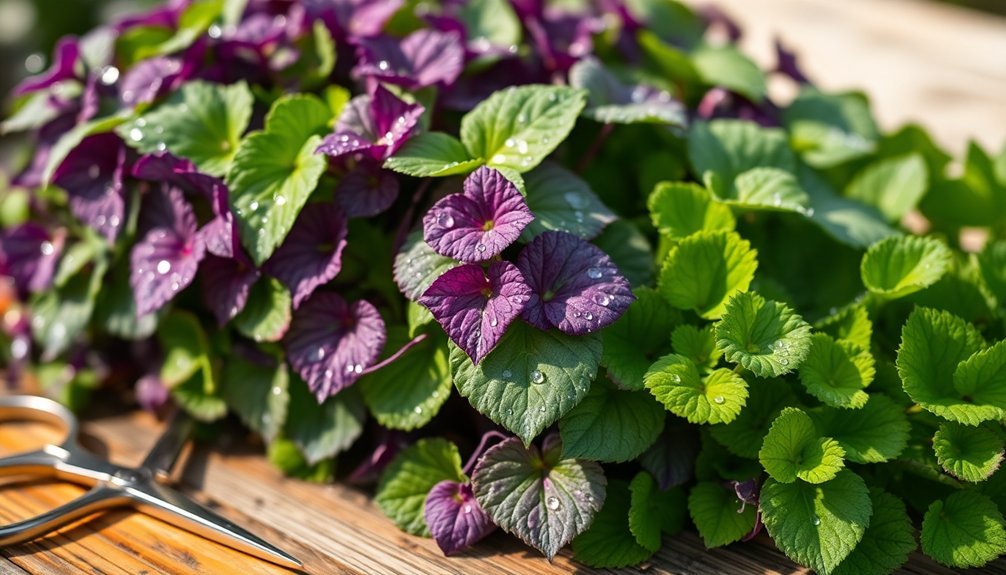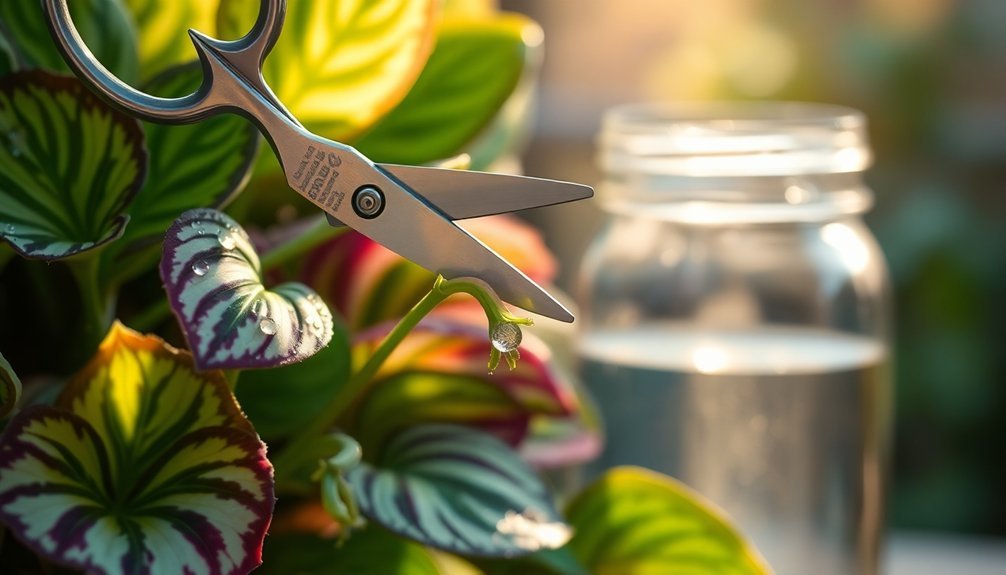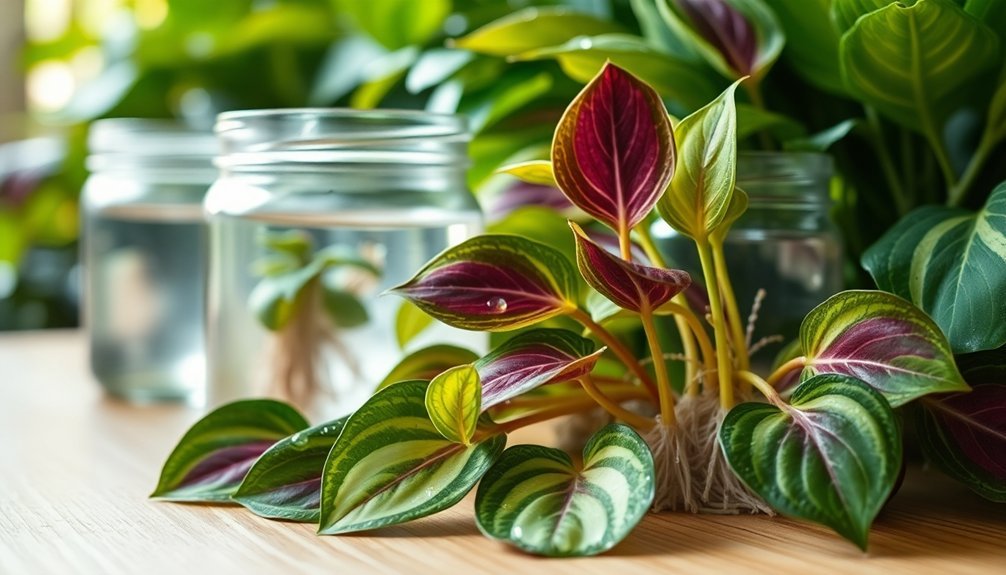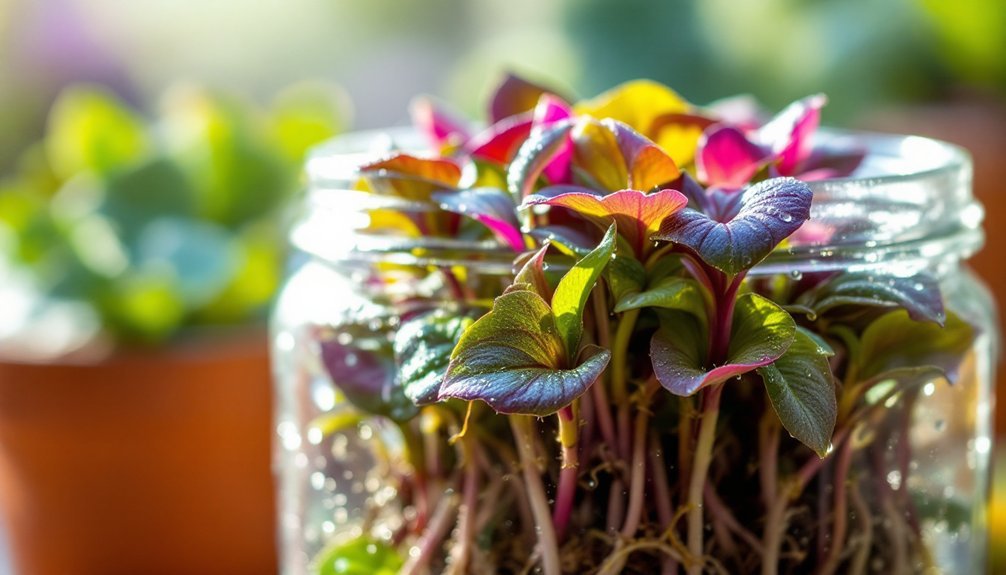To propagate tradescantia, start by selecting healthy 3-6 inch stems and cutting them at a 45° angle below a leaf node. Remove leaves from the bottom two-thirds of each cutting, then place them in water with nodes submerged or directly in well-draining soil. Keep your cuttings in bright, indirect light and maintain consistent moisture. You'll see roots develop within 1-2 weeks. Follow our complete guide for expert tips to maximize your propagation success.
Selecting and Inspecting Healthy Parent Plants

Three key factors determine successful Tradescantia propagation, with the most crucial being the selection of a healthy parent plant.
To begin, move your plant to a well-lit area where you can thoroughly inspect it for signs of pests or damage, paying special attention to the undersides of leaves.
When selecting stems for cuttings, look for vibrant, sturdy ones that show no signs of withering or damage. You'll want to avoid any stems that appear half dead, as these won't lead to successful propagation.
The overall health of your parent plant directly impacts the success of your cuttings, so take time to evaluate the plant's conditions.
Watch for seasonal changes that might affect your plant's liveliness – if you notice crispy leaves or leggy growth, these could indicate stress or poor growing conditions.
Essential Tools and Pre-Propagation Setup
Before diving into Tradescantia propagation, you'll need to gather a few essential tools and create the right environment for success.
Start by collecting sharp cutting tools, like sterilized scissors or pruning shears, which you'll sanitize with rubbing alcohol to prevent disease spread. You'll also need small containers filled with either well-draining soil or water for propagation, and optional rooting hormone to boost success rates.
Time your propagation during active growing seasons – spring and summer – when healthy stems are most likely to root.
Set up your workspace in a bright area away from direct sunlight, giving you ideal conditions to inspect and cut your plant. Make certain you have potting mix ready if you're using soil propagation, though water propagation works equally well for Tradescantia.
Taking Perfect Stem Cuttings

With your tools ready and workspace prepared, taking the right stem cuttings will make or break your propagation success. To propagate tradescantia effectively, select healthy stems that are 3-6 inches long with at least a few leaves attached. Look for vibrant branches without damage or discoloration.
Make a clean cut just below a leaf node at a 45° angle using sterilized cutting tools. This precise angle promotes ideal root development. Remove the leaves from the bottom two-thirds of each cutting – this prevents rotting when they're submerged in water and enhances rooting potential.
For best results, you can dip the cut ends in rooting hormone before placing them in your chosen growing medium. Keep your cuttings organized by similar lengths, and avoid disturbing the prepared ends before propagation.
Water vs. Soil Rooting Methods
Once you've prepared your cuttings, you'll need to choose between water or soil propagation methods – each offering distinct advantages.
Water propagation lets you monitor progress easily as roots develop within 1-2 weeks, making it perfect if you're new to propagating Tradescantia Zebrina. Simply place your cuttings in water with at least one node submerged.
Soil propagation often leads to faster root establishment and stronger growth. Place your cuttings directly in well-draining soil, ensuring the node is below the soil line.
While this method requires more supplies, it eliminates the transplanting step needed with rooting in water.
Your successful propagation ultimately depends on personal preference. Water propagation needs minimal equipment, while soil propagation might cost more initially but produces hardier roots.
Both methods work effectively for Tradescantia – choose what suits your style and experience level.
Nurturing Your New Tradescantia Plants

Successfully propagated Tradescantia cuttings need proper care to thrive in their new environment. For ideal success rate, place your young Tradescantia in bright, indirect light, away from harsh sun that can damage the leaves.
Keep the soil moist but never waterlogged, allowing the top layer to dry slightly between waterings. Good drainage is vital for healthy root development, so make sure your pots have adequate drainage holes.
During the growing season, support your new plants' growth with half-strength, water-soluble fertilizer every 4-6 weeks.
Watch for signs that your propagation isn't going as planned, such as yellowing leaves or wilting. These symptoms often indicate improper water or light conditions.
If you notice any issues, adjust your care routine promptly to guarantee your Tradescantia thrives in its new home.
Frequently Asked Questions
How to Propagate Tradescantia From Cuttings?
Take 3-6 inch stem cuttings below a node at 45°. Remove lower leaves, place in water or soil with nodes submerged. Once roots grow 1-2 inches, transfer to potting mix.
Is It Better to Propagate Tradescantia in Water or Soil?
You'll succeed with either method, but soil propagation offers faster growth and stronger roots. If you're new to propagating, water propagation lets you monitor root development easily and provides great visual satisfaction.
How Do You Propagate Step by Step?
Cut a healthy stem below a node at 45°. Remove lower leaves. Place in water or soil, ensuring the node's covered. Keep in bright indirect light. Wait for roots to grow 1-2 inches before transplanting.
How Long Does It Take for Tradescantia to Root in Water?
You'll notice roots starting to form within the first week, and it'll take 1-2 weeks total for your Tradescantia to develop strong roots in water. Keep the water fresh for best results.
In Summary
You've now got all the knowledge needed to successfully propagate your tradescantia plants. Whether you've chosen water or soil propagation, remember to maintain consistent moisture levels and warm temperatures. Keep an eye out for new growth, and don't be discouraged if your first attempt isn't perfect. With these simple steps and a bit of patience, you'll soon have a thriving collection of these beautiful trailing plants.





Leave a Reply